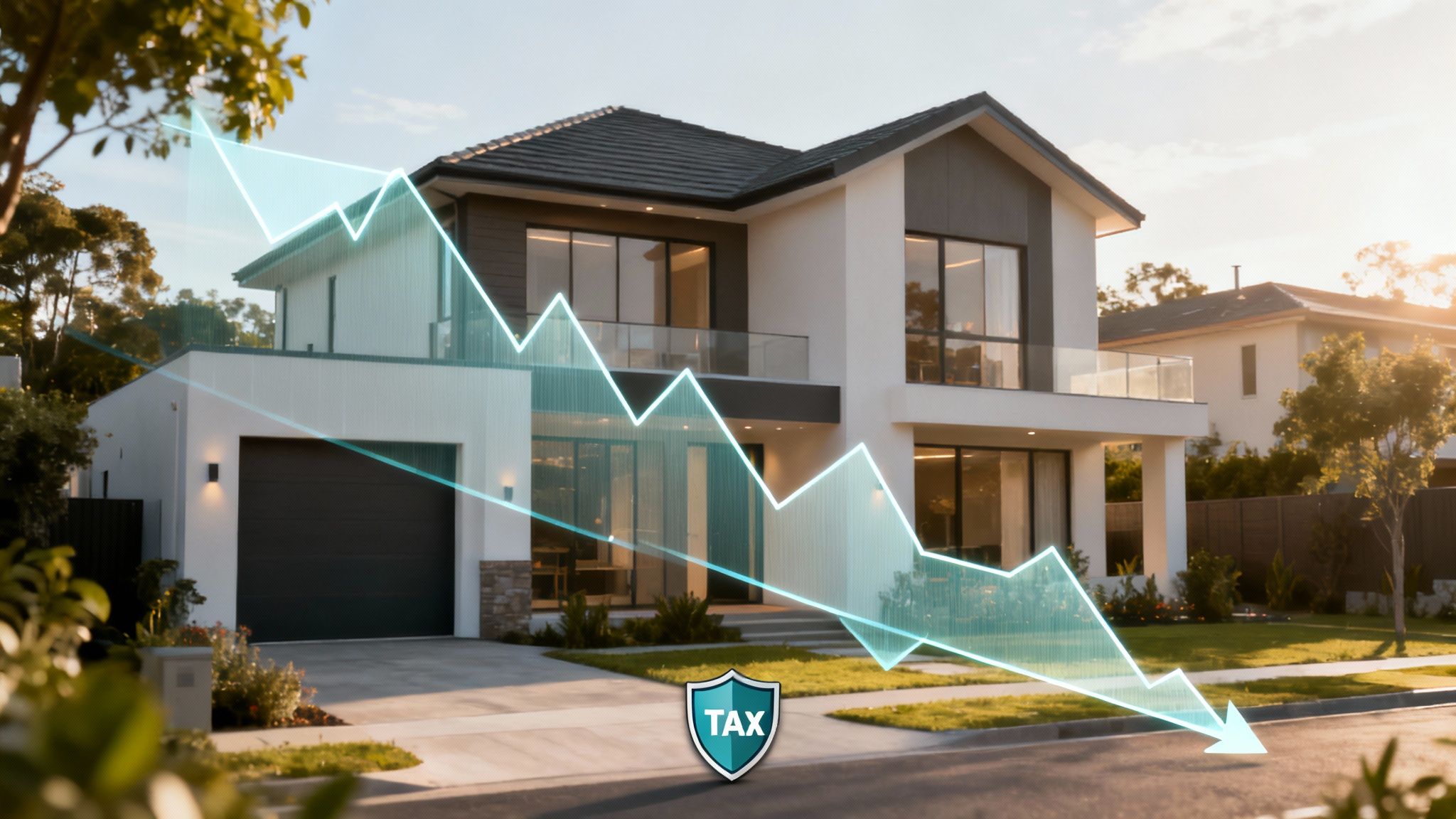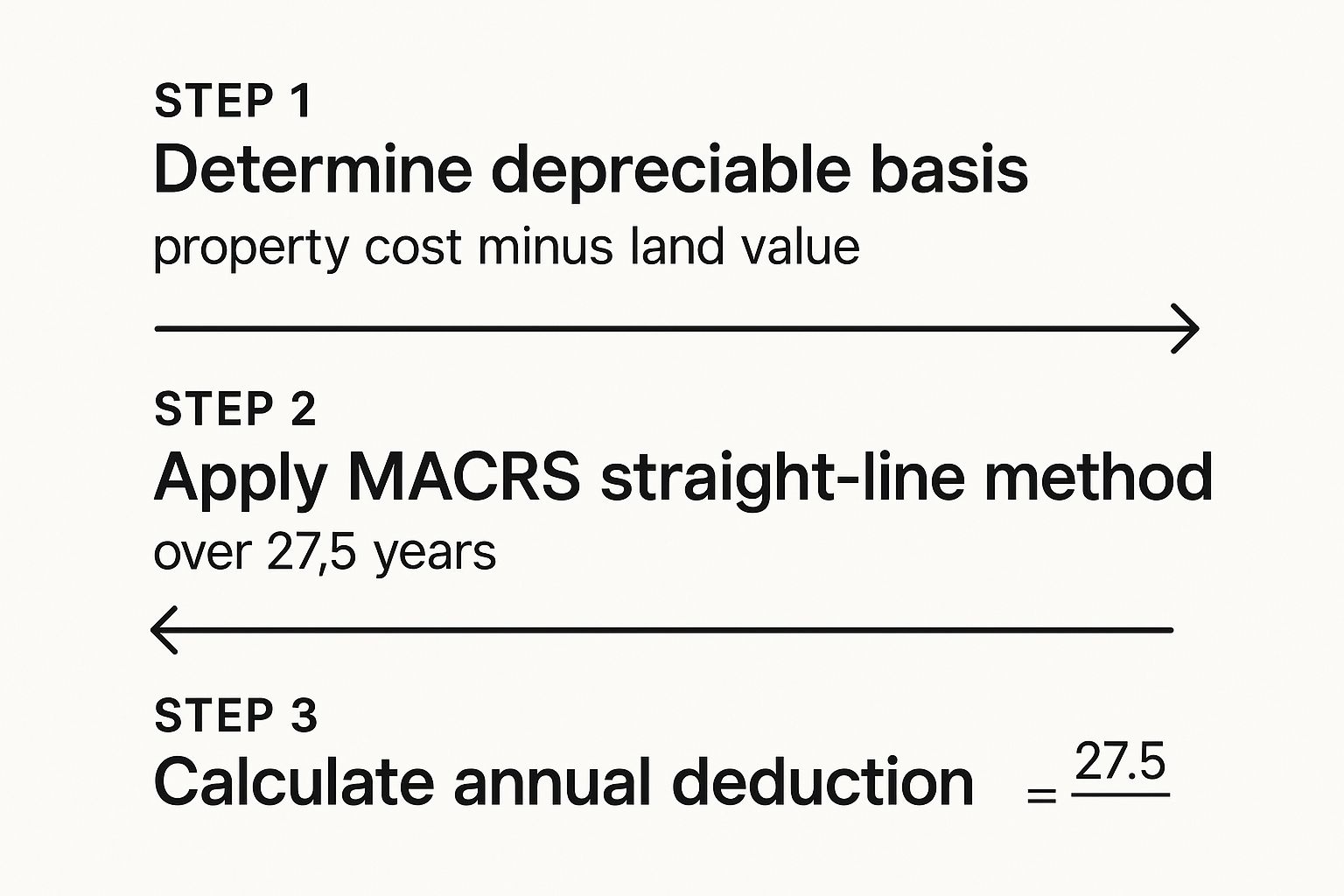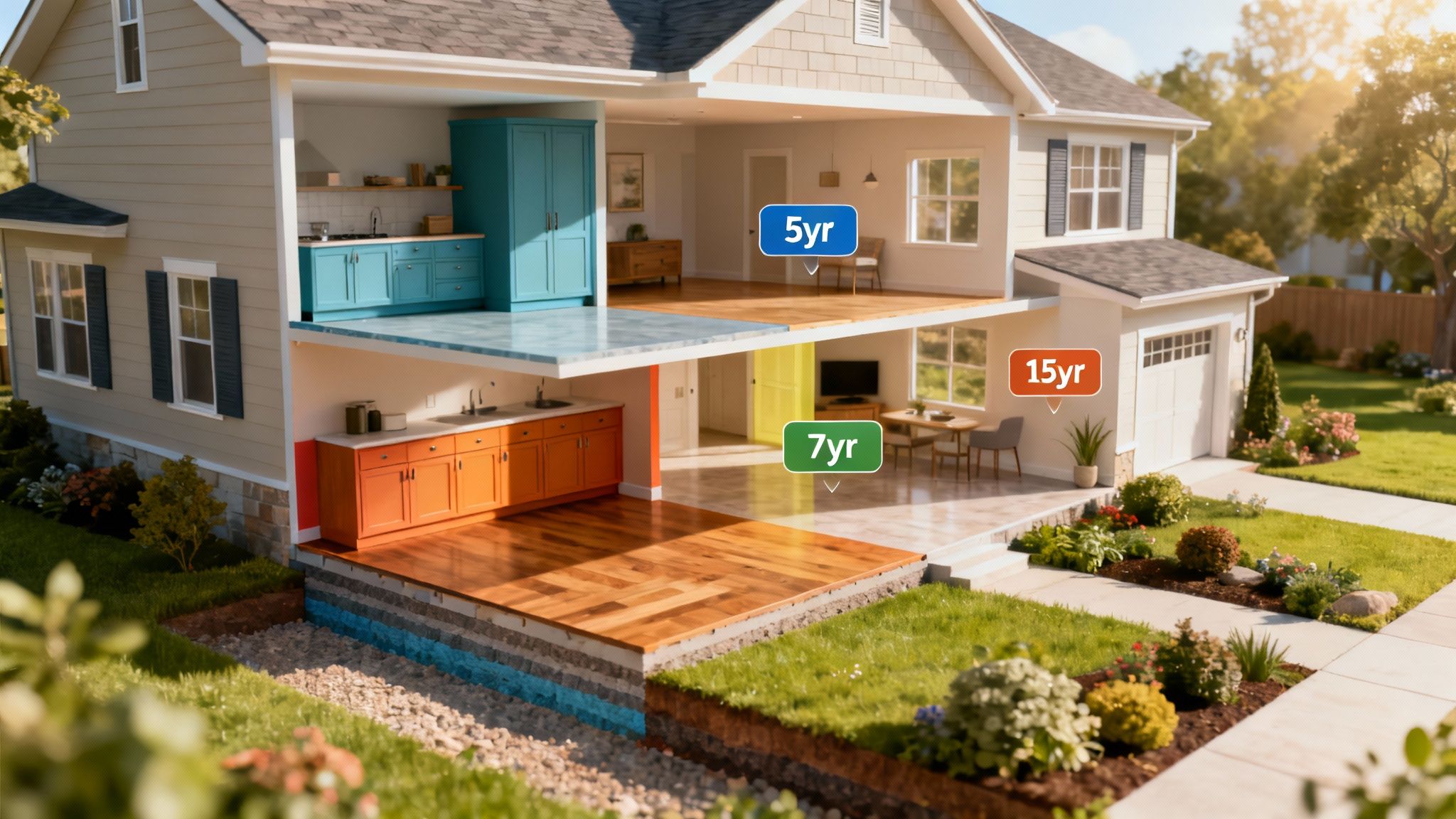A Guide to San Diego Rental Property Depreciation Rules That Boosts Your ROI
- Mark Palmiere

- 5 days ago
- 14 min read
TL;DR: Key Depreciation Insights for San Diego Investors
What it is: Depreciation is a powerful tax deduction allowing you to write off a portion of your property's cost over its "useful life," lowering your taxable income.
Standard Timeline: Residential rental properties in the U.S. are depreciated over a 27.5-year period using the straight-line method.
Basis Calculation: Your depreciable amount is the property's purchase price plus closing costs, minus the value of the land.
Advanced Strategy: Cost segregation studies can accelerate deductions by reclassifying property components into shorter 5, 7, or 15-year recovery periods.
Depreciation Recapture: When you sell, the total depreciation claimed is "recaptured" and taxed at a maximum rate of 25%. A 1031 exchange can defer this tax.
Rental property depreciation is one of the most powerful tools in a real estate investor's tax arsenal. It lets you write off a portion of your property's cost over its "useful life," significantly lowering your taxable income. The best part? You get this tax break even while your property is likely appreciating in market value. At West Coast HomeStays, we help San Diego owners master these rules to boost their revenue by 20-30% on average, combining smart financial strategy with five-star, hands-off management.
Your Guide to Understanding Depreciation

Let's dive into one of the biggest tax advantages available to property investors. Understanding rental property depreciation rules isn’t just for your CPA—it's a critical strategy for boosting your cash flow and building wealth. For San Diego property owners, getting this right is key to maximizing returns in our competitive market.
At its core, depreciation is just an accounting method. It allows you to deduct a piece of your property's cost each year, creating a "paper loss" that reduces your real tax bill. Think of it as the IRS acknowledging that buildings and their components wear out over time, regardless of what the market is doing. This savvy, data-driven approach is key to a profitable rental strategy, which is about much more than just a full booking calendar.
Why Depreciation Matters for Your Bottom Line
Depreciation isn't just a random line item on your tax return; it's a fundamental tool for improving your property's financial performance. Here’s why it’s such a big deal:
Boosts Annual Cash Flow: By slashing your taxable income, depreciation leaves more cash in your pocket at year's end without ever touching the rent you collect.
Reduces Tax Liability: It directly offsets your rental income, which means you pay less to Uncle Sam and keep more of what you earn.
Enhances Overall Returns: A smaller tax bill translates directly to a higher net return on your investment, helping you hit your financial goals faster.
To get the most out of your rental properties, it's smart to see how depreciation works alongside other effective tax strategies for real estate investors. While it's a huge piece of the puzzle, a well-rounded financial plan will use every deduction available.
This guide will break it all down, from the basic principles to advanced strategies like cost segregation. We'll give you a clear roadmap to turn complex tax rules into a powerful financial advantage. And while this is a great place to start, don't forget to look at the bigger picture. Our [rental property tax deductions checklist](https://www.westcoasthomestays.com/post/rental-property-tax-deductions-checklist-6-must-know-write-offs-for-2025) will make sure you’re not leaving any money on the table.
What Is Depreciation and How Does It Work
Let’s talk about one of the most powerful—and often misunderstood—perks in real estate investing: depreciation. If you've ever bought a new car, you know it loses value the second you drive it off the lot. With a rental property, that "loss" is actually a huge win on your tax return, acting as a financial shield for your income.
At its core, depreciation is a yearly tax deduction that lets you recover the cost of your investment property over what the IRS considers its "useful life." The government gets that buildings, appliances, and fixtures wear out. So, they let you claim a "paper loss" each year, which lowers your taxable income without a single dollar actually leaving your pocket.
For smart investors, this isn't just an accounting term; it's a non-cash deduction that transforms a complex tax rule into a real, tangible benefit year after year.
Understanding the Key Terms
To really nail your rental property depreciation rules, you need to get a handle on a few core concepts. Think of these as the building blocks for unlocking this tax benefit.
Depreciable Basis: This is your starting number. It's what you paid for the property, plus some closing costs, minus the value of the land. The IRS sees land as something that doesn't wear out, so you can only depreciate the structure, not the dirt it sits on.
Recovery Period: This is the timeline the IRS gives you to write off the property's value. For residential rental properties in the U.S., that's a standard 27.5 years.
Placed in Service: Depreciation doesn't kick in the day you close. It starts when the property is officially "placed in service"—meaning it's ready and available to be rented, even if you haven't found a tenant just yet.
Getting these three elements right is the foundation of your annual depreciation calculation. It's why keeping meticulous records from day one is so critical, a job that's a whole lot easier with the [best accounting software for real estate investors](https://www.westcoasthomestays.com/post/12-best-accounting-software-for-real-estate-investors-2025).
A Practical San Diego Example
Let's make this real with a hypothetical rental in Pacific Beach. Say you buy a condo for $800,000. After getting an appraisal, you find out the land itself is worth $250,000.
First, you need to find your depreciable basis, which is just the building's value:$800,000 (Total Cost) - $250,000 (Land Value) = $550,000 (Depreciable Basis)
Next, we'll use that standard recovery period. In the United States, rental property depreciation rules mandate a 27.5-year straight-line depreciation schedule. "Straight-line" just means you deduct the same amount every single year.
To get your annual deduction, you just divide your basis by the recovery period:$550,000 (Depreciable Basis) ÷ 27.5 years = $20,000 per year
This $20,000 deduction is pure gold. It directly reduces your taxable rental income every year. If your property brought in $35,000 in net operating income, you’d only pay taxes on $15,000 of it, leaving significantly more cash in your bank account.
This simple math shows just how powerful depreciation is. It’s a steady, predictable tax benefit that works for you every year, making your San Diego investment property an even smarter financial move.
Calculating Depreciation with MACRS
Alright, let's get into the mechanics. The IRS doesn't leave depreciation up to guesswork; they have a specific framework called the Modified Accelerated Cost Recovery System (MACRS) that tells you exactly how to write off your rental property.
The good news? For residential real estate, MACRS is surprisingly straightforward. It uses the straight-line method, meaning you deduct the same exact amount year after year. There are no complicated formulas or changing percentages to track—just one consistent deduction that makes your financial planning a whole lot easier.
This predictability is a huge win for property owners. It lets you budget reliably and gives you a clear picture of your tax savings every single year, which is crucial for maximizing the long-term profitability of your San Diego investment.
The 27.5 Year Rule for Residential Properties
Under MACRS, the IRS has decided that the "useful life" of a residential rental building is 27.5 years. Think of this as the official recovery period you'll use for your annual depreciation calculation.
This timeline is set in stone by the tax code. It doesn't matter if your property is a brand-new build in Carlsbad or a historic home in La Jolla—the structure itself has to be depreciated over that 27.5-year span.
Not All Assets Are Created Equal
While the building gets a long recovery period, not everything inside or around your rental is treated the same. This is where smart investors can speed up their tax deductions.
Many components of your property have a much shorter "useful life" in the eyes of the IRS. If you correctly separate these items, you can significantly boost your deductions in the early years.
5-Year Property: This bucket usually includes personal property like new appliances (think refrigerators, washers, and dryers), carpeting, or any furniture you provide for tenants.
15-Year Property: This is where you’ll find land improvements. Things like adding a new fence, upgrading the landscaping, or paving a driveway typically fall in here.
By depreciating these assets over their shorter 5 or 15-year schedules, you get to claim bigger deductions upfront. This front-loads your tax savings and puts more cash back in your pocket right away. The trick is to separate these costs from the building's main value.
Putting It All Together: A Step-by-Step Calculation
Calculating your annual depreciation deduction is a simple, three-step process. You just need to figure out your depreciable basis and then apply the correct MACRS schedule.
This infographic breaks down the workflow for calculating the annual deduction on your rental property's structure.

As you can see, the core calculation is simple: divide your building's value by the standard 27.5-year recovery period, and you've got your annual write-off.
Let’s walk through it with a San Diego example:
Determine Your Property's Cost Basis: Start with the purchase price plus certain closing costs. Let's say you bought a duplex in Oceanside for $950,000.
Separate the Land Value: Land never depreciates. If an appraisal values the land at $300,000, you have to subtract that from your total cost.
Calculate Your Depreciable Basis: * $950,000 (Total Cost) - $300,000 (Land Value) = $650,000 (Depreciable Basis)
Calculate Your Annual Deduction: * $650,000 (Depreciable Basis) ÷ 27.5 years = $23,636 per year
This $23,636 is the amount you can deduct from your rental income each year for the next 27.5 years. It’s a powerful, non-cash expense that directly reduces your taxable income and improves your property's financial performance.
Navigating rental property depreciation rules is a critical part of a successful investment strategy. At West Coast HomeStays, we help owners see the bigger picture, ensuring their properties are not only booked but also financially optimized.
Supercharge Deductions with Cost Segregation

While the standard 27.5-year MACRS schedule provides a steady, long-term tax benefit, what if you could pull those deductions forward and get a massive tax break now? That’s exactly what a savvy strategy called cost segregation does. For serious investors, it’s one of the most powerful ways to boost your rental property’s cash flow right out of the gate.
Instead of lumping your entire property into one big asset that depreciates over nearly three decades, a cost segregation study meticulously breaks it down into individual parts. This detailed, engineering-based analysis identifies and reclassifies components of your property into much shorter recovery periods—think 5, 7, or 15 years.
The result? You front-load your depreciation deductions, generating huge tax savings in the early years of ownership when cash flow is often the tightest. It’s a game-changer.
How a Cost Segregation Study Works
Think of your San Diego rental not as a single building, but as a collection of hundreds of different items assembled together. A cost segregation study is essentially an inventory of every single one of those items, assigning each its correct, shorter lifespan according to IRS rules.
To do this, specialized engineers and tax pros conduct a deep dive into your property. They’ll pour over blueprints, contractor invoices, and the physical property itself to separate personal property (like appliances) and land improvements (like a driveway) from the building’s core structure.
The goal is to produce a highly detailed report that shifts a big chunk of your property's purchase price into these shorter-lived asset classes. This unlocks much larger depreciation deductions, much sooner.
For owners focused on maximizing returns, this isn't just an accounting trick; it's a fundamental financial strategy. To dive deeper into optimizing your financials, you can explore our comprehensive guide to maximizing your San Diego short-term rental tax deductions.
Unlocking Faster Write-Offs
The real magic of cost segregation is in pinpointing all the assets the IRS agrees have a shorter useful life. This gives you a whole new level of control over your rental property depreciation rules.
Here’s a look at what a typical study might find in a San Diego vacation rental:
5-Year Property: This bucket includes assets that aren't permanently part of the building. We're talking about things like carpeting, appliances, blinds and curtains, and even certain types of decorative lighting.
15-Year Property: This covers improvements made to the land around the building. Common examples include driveways, fences, swimming pools, retaining walls, and landscaping.
By carving out these items, you can depreciate them over a much faster 5 or 15 years instead of being stuck with the standard 27.5.
A Real-World San Diego Example
Let's put some numbers to this. Imagine you just bought a beautiful vacation home in La Jolla for $1.5 million. After subtracting the land value, your depreciable basis for the building is $1.1 million.
Without Cost Segregation: Your annual deduction is simple: * $1,100,000 ÷ 27.5 years = $40,000 per year
Now, let's say you invest in a cost segregation study. The engineers determine that 20% of the building's value can be reclassified into shorter-lived assets.
With Cost Segregation: Suddenly, the numbers look very different. * 15% ($165,000) is moved to a 5-year schedule (for flooring, cabinets, etc.). * 5% ($55,000) is moved to a 15-year schedule (for a new patio and landscaping).
The remaining 80% ($880,000) stays on the 27.5-year schedule. This strategic shift creates a much, much larger tax deduction in the first few years, giving you a significant cash flow boost and improving your property's overall return.
🌟 Spotlight on West Coast HomeStays✔ 20–30% revenue boost through our hybrid STR + MTR strategy✔ Five-star guest experiences with boutique-level service✔ Proven results backed by data-driven dynamic pricing👉 **Book a strategy call today!**
Depreciation Rules for International Properties
For real estate investors dipping their toes into global markets, it’s crucial to understand how rental property depreciation rules change once you cross the border. The big idea is still the same—spreading a property's cost over its useful life—but the timelines and fine print can look very different from the U.S. standards you’re used to.
Taking your portfolio international is exciting, but it definitely adds a new layer of tax complexity. You’ll be juggling the tax laws of the country where your property sits and your U.S. tax reporting duties. Getting this dual compliance right is a non-negotiable part of a winning international rental strategy.
One of the biggest differences you'll run into right away is the recovery period for residential properties. This is the timeline over which you can claim deductions, and it’s fundamental to getting your numbers right.
The U.S. 27.5-Year vs. The 30-Year Foreign Standard
In the United States, residential rental properties are depreciated over a standard 27.5-year period. That’s the magic number for domestic investors.
But when you invest abroad, that number often gets a bit longer. While rules vary worldwide, a common standard for foreign residential properties is a 30-year depreciation period. This means investors with international properties deduct a slightly smaller amount each year, but they get to spread those deductions over an extra 2.5 years. You can learn more about international depreciation standards to see how these rules might apply in different countries.
This isn't just a minor tweak; it directly hits your annual cash flow and tax bill. A longer recovery period means your total deduction gets stretched thinner, resulting in a smaller write-off each year.
A Quick Numerical Comparison
Let's break down the real-world impact with a simple example. Imagine you buy a rental property with a depreciable basis of $400,000, whether it's in San Diego or Lisbon.
U.S. Property (27.5-Year Schedule): * $400,000 ÷ 27.5 years = $14,545 annual deduction
Foreign Property (30-Year Schedule): * $400,000 ÷ 30 years = $13,333 annual deduction
In this scenario, the U.S. property gives you an extra $1,212 in tax deductions every single year. While the foreign property's deductions last longer, the U.S. schedule provides a more powerful annual tax shield, which improves your yearly cash flow.
Navigating these international rules demands careful planning and, frankly, the guidance of a tax pro who knows their way around cross-border investments. For investors focused on the powerhouse San Diego market, working with a local expert like West Coast HomeStays keeps things simple. We ensure your strategy is dialed in for U.S. tax law, maximizing your returns without the headache of foreign regulations. Our focus is on leveraging every local advantage to make your property perform at its peak.
Understanding Depreciation Recapture When You Sell

Depreciation is a fantastic tax benefit while you own a rental property, but the story isn't over when you decide to sell. Those tax deductions you’ve been taking don't just disappear into thin air. They reappear through a process called depreciation recapture.
Think of it as the IRS’s way of settling the score. You got a tax break for the property's wear and tear over the years, and now it's time to account for that benefit when you cash out. It’s not a penalty, just a crucial tax rule every smart investor needs to plan for.
What Is Depreciation Recapture?
Depreciation recapture is a core concept in rental property depreciation rules. Every year you claim depreciation, you lower your property's adjusted cost basis. This is great for your annual taxes, but it creates a tax liability that comes due when you sell.
The total amount of depreciation you've claimed over the years is subject to a recapture tax, which is capped at a maximum rate of 25%. It's important to remember this is calculated separately from your standard capital gains tax. You're essentially paying back some of the tax savings you enjoyed, but at a special, fixed rate.
How Recapture Is Calculated
Let’s run through a quick example to make this crystal clear. Say you sell your San Diego rental property for $900,000.
Here are the numbers for your property:
Original Purchase Price: $600,000
Total Depreciation Claimed: $100,000
Adjusted Cost Basis: $600,000 (Purchase Price) - $100,000 (Depreciation) = $500,000
First, we need to figure out your total gain from the sale:
Total Gain: $900,000 (Sale Price) - $500,000 (Adjusted Basis) = $400,000
Now, here's where the IRS splits that gain into two different buckets for tax purposes:
Depreciation Recapture: The first $100,000 of your gain (which matches the depreciation you took) gets taxed at the recapture rate, up to 25%.
Capital Gain: The leftover $300,000 is taxed at your long-term capital gains rate (which could be 0%, 15%, or 20% depending on your income).
Getting this distinction right is the key to knowing what you'll actually walk away with after taxes. Our [San Diego rental property cash flow calculator](https://www.westcoasthomestays.com/post/san-diego-rental-property-cash-flow-calculator-your-guide-to-higher-profits) is a great tool for modeling these kinds of long-term financial outcomes.
Strategies to Manage Recapture Tax
The good news? You aren't stuck with this tax bill. There’s a powerful strategy investors have used for decades to kick this can down the road: the 1031 exchange.
A 1031 exchange allows you to sell an investment property and roll the entire proceeds into a new, "like-kind" property. When you do this correctly, you can defer paying both depreciation recapture and capital gains taxes.
This lets you keep your entire profit working for you in a new investment, which is a cornerstone strategy for building serious real estate wealth. For San Diego investors, it's an indispensable tool for growing a portfolio. At West Coast HomeStays, we help owners navigate these long-term financial plays, making sure every move—from buying to selling—is optimized for the best possible return.
Frequently Asked Questions About Depreciation
1. What makes West Coast HomeStays different from other managers?
We combine data-driven financial optimization with boutique, five-star hospitality. Our hybrid STR + MTR strategy, design expertise, and dynamic pricing typically boost owner revenue by 20-30% while providing guests with unforgettable, amenity-rich stays. We're not just managers; we're your investment partners.
2. Can you handle both short- and mid-term stays?
Absolutely. Our hybrid STR + MTR model is our specialty. It keeps your calendar full year-round by capturing high-season vacationers (short-term) and filling shoulder seasons with traveling professionals, relocating families, and insurance placements (mid-term), maximizing your occupancy and income.
3. How quickly can my listing be optimized?
Our onboarding process is efficient and thorough. After an initial strategy call, we can typically have your listing professionally photographed, expertly written, and optimized with dynamic pricing within 2-4 weeks, depending on any recommended design upgrades.
4. What amenities do your San Diego homes include?
Our properties are known for being stylish and amenity-rich. Standard amenities include high-speed Wi-Fi, premium linens, fully-equipped kitchens, and smart home tech. Many of our curated coastal homes also feature pools, hot tubs, outdoor fire pits, and family-friendly extras like beach gear and games.
5. Do you help with design upgrades to boost nightly rates?
Yes, this is a core part of our value. We provide expert design consultations to identify high-ROI upgrades—from a simple furniture refresh to minor renovations—that make your property stand out, command higher nightly rates, and attract five-star reviews.
If you’re ready for truly hands-off, higher-earning rentals in San Diego, West Coast HomeStays is the partner to trust. **Book a strategy call today!**

Comments